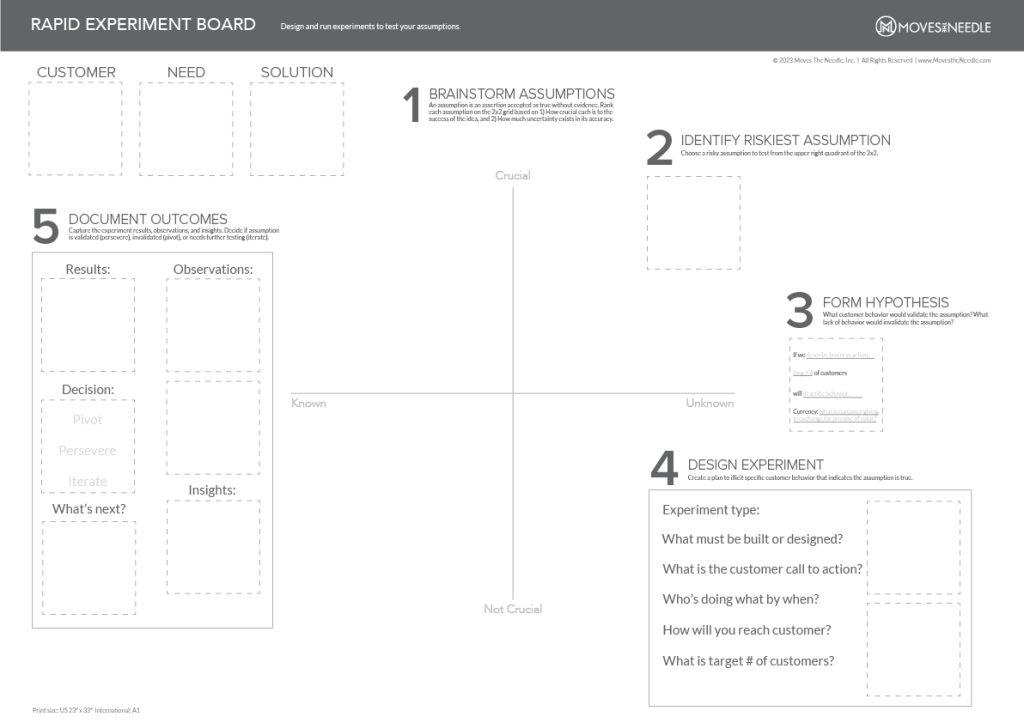
In the complexity of the globally-connected digital world, uncertainties and the assumptions on how to overcome them, hinder organizations from achieving their objectives. Enter rapid experimentation – a dynamic process that allows businesses to test ideas, challenge assumptions, and reduce the risk of failing. Rapid experimentation holds immense value in generating evidence to support decision-making, inform strategies, and propel businesses toward success.
The Foundation of Rapid Experimentation
At its core, rapid experimentation mirrors the scientific approach to exploring and explaining facts. In the realm of business, a new idea serves as a theory, relying on various assumptions. While some assumptions are supported by evidence and facts, others remain unproven, disguised as certainties where little exists. Rapid experimentation aims to expose and test these assumptions to bridge the gap between theoretical hypotheses and real world fruition of an idea.
It is a mindset that should permeate the entire organization, empowering every team everywhere to identify uncertainties in their work and conduct experiments to overcome them.
Origins and Growth of Rapid Experimentation
Experimentation has long been a part of business practices. However, the rise of Lean Startup methodologies, popularized by Eric Ries in his book “The Lean Startup,” brought rapid experimentation to the forefront. Ries’s emphasis on Minimum Viable Products (MVPs) sparked a paradigm shift. This shift highlights the need for purposeful and disciplined experiments throughout the entire business model, beyond product development alone. Around the same time, “The Four Hour Workweek” author Tim Ferris’s experimentation-driven landing page tests popularized low cost idea validation. These perspectives opened doors for entrepreneurs, startups, and large organizations exploring the uncertainties inherent in building new businesses.
Embracing Rapid Experimentation Across Business Functions
Rapid experimentation has the potential to transform not only product development, but also marketing, sales, operations, supply chain management, and back office functions like HR and Legal teams. It is a mindset that should permeate the entire organization. Every team should be empowered everywhere to identify uncertainties in their work and conduct experiments to overcome them. By doing so, businesses can optimize execution, discover market opportunities, and find new growth.
Clarifying the Minimum Viable Product (MVP)
The concept of Minimum Viable Product (MVP) often intertwines with experimentation but requires clarification. An MVP represents the minimum version of a product that is viable and aligns with user needs and business objectives. It is a type of experiment, but distinct from tests like a landing page. While landing pages serve as experiments to test messaging or idea articulation, or even pricing, an MVP encompasses elements of the desirability, viability, and feasibility of an idea; as championed by the Kelley brothers’ IDEO and their design thinking approach to new product development. Not all experiments are MVPs, but all MVPs are indeed experiments. An MVP is a product experiment with a very high degree of fidelity.
Rapid experimentation is a formidable tool that can help navigate this ambiguity, test assumptions, overcome biases and propel organizations toward success.
Debunking the “Embarrassment” Notion
Reid Hoffman, co-founder of LinkedIn is famously quoted as saying, “If you’re not embarrassed by your product, you’ve launched too late.” It’s a thought-provoking sentiment, but launching an embarrassing product may not be considered an MVP, particularly within the context of established businesses with existing customer bases. While speed and agility are vital, positing that a product version is viable to a select group of early adopters is different than broadly launching an embarrassing product.
Starting the Rapid Experimentation Journey
To embark on the path of rapid experimentation, you want to identify a challenge that represents uncertainty within the business (If there’s already evidence, you don’t need to experiment). Such challenges exist all across the enterprise; some small, some big. For example, how might you use AI to enhance internal efficiency, reduce costs in manufacturing, expand into new markets, improve customer satisfaction, foster employee retention, promote sustainability and diversity, and so on. Once the challenge is identified, it can be framed into a series of hypotheses that can be tested.
Crafting Assumptions and Prioritizing Risk
Assumptions describe all the things that hold true for an idea to be desirable, viable, and feasible. They encompass a wide range of factors related to customer needs, behavior, willingness to pay, how to reach them, what messages they will respond to, and how they make decisions to buy. The next step involves ranking assumptions based on their relative criticality to the idea’s success and the level of evidence that exists in support of the assumption. The greatest risk are those assumptions that are the most crucial to the business and the highest degree of uncertainty.

To download this board click here
Designing Experiments for Success
All products ask people to change their behavior. When designing experiments, create a hypothesis that outlines specific actions the business will take and the specific expected behaviors desired from a targeted customer segment. The goal is to craft experiments that act as proxies for building the actual product, providing valuable data as to whether a customer might exhibit the required behavior. Various experimentation techniques can be employed, including landing page tests, concierge experiments, and so on, but it’s open to the creativity of the designers.
The Power of Rapid Experimentation
Given the nature of the fast-moving digital world, uncertainty lurks around every corner. Rapid experimentation is a formidable tool that can help navigate this ambiguity, test assumptions, overcome biases and propel organizations toward success. It can help reduce uncertainty, generate evidence, and ultimately, help drive business growth. Through the process of experimentation, organizations make well-informed decisions and increase their chances of achieving desired outcomes.
By embracing a mindset of continuous learning and experimentation, business leaders can refine their strategies, deliver products that resonate, and improve efficiency throughout the organization. Through the systematic implementation of rapid experimentation, businesses can unlock new opportunities, optimize their operations, and build a solid foundation for sustainable growth.
If you’re looking for help with implementing rapid experimentation within your organization, email brant@movestheneedle.com to schedule a free call.
BRANT COOPER, The New York Times bestselling author of The Lean Entrepreneur and Disruption Proof and CEO and founder of Moves the Needle, is a trusted adviser to startups and large enterprises around the world. With more than 25 years of expertise in changing industrial age mindset into digital age opportunity, he blends agile, human-centered design, and lean methodologies to ignite entrepreneurial action from the front lines to the C-suite.
